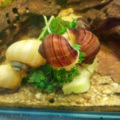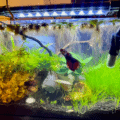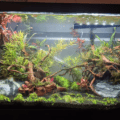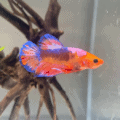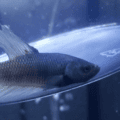Navigating the realm of aquarium care can be a daunting task, especially when it comes to ensuring the water is safe for your aquatic companions. While over-the-counter water conditioners offer a quick solution, they also pose potential risks to your fish if not used properly. So let’s dive in and ensure the well-being of our finned companions with care and caution every step of the way.
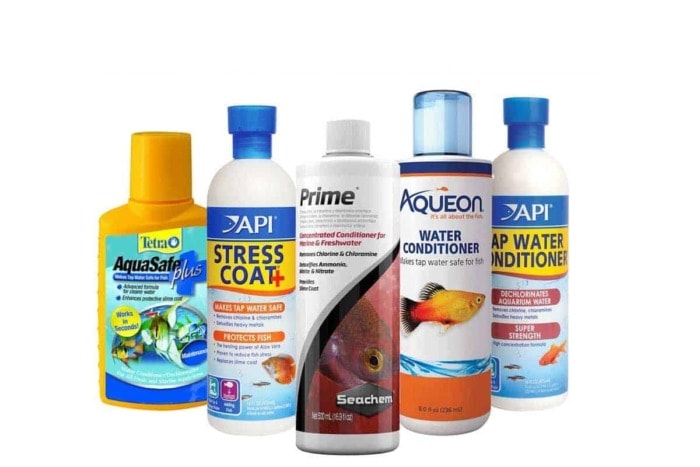
Even though water conditioners are one of the fastest ways to dechlorinate tap water, they can kill fish on some rare occasions.
And more often than not, it’s not the conditioner that’s actually doing the killing.
Keep on reading to find out how you can safely dechlorinate the tap water in your fish tank.
Can using a water conditioner accidentally kill aquarium fish?
I’ve heard reluctant aspiring aquarists voice concerns about water conditioners several times.
One that stood out to me over the years was when the toddler of an aquarist thought she’d help during the water change. She started dumping an open bottle of Seachem Prime into his 50-gallon tank while his back was turned!
Thankfully, the bottle was almost empty and no fish lost their lives. His fish were lucky that day.
But aren’t such products designed to help our aquariums?
Here’s when adding a water conditioner can accidentally kill fish:
Water conditioners dechlorinate water by using special chemicals which bind to chlorine. Most dechlorinators use up oxygen in the process, typically in negligible amounts. However, overdosing on water conditioner can harm fish in poorly oxygenated aquariums.
The good news is, if you’re worried about oxygenation problems in your aquarium, this is often an easy fix:
- Increase water movement. Adding an airstone, or a power filter to the tank will move the water’s surface. This movement increases the absorption of oxygen and the release of carbon dioxide between the aquarium and the air in the room.
- Fix overstocking if there’s any. Keeping too many fish can lead to a plethora of problems, one being low oxygen levels in their aquarium. Because there is too much bioload, bacteria are constantly working to process it, consuming oxygen in the process.
- Consider your aquarium’s water temperature. Warm water holds less oxygen compared to colder water. This may become a problem if you keep tropical fish at water temperatures upwards of 80°F (27°C).
Anyway, there are many ways you can add water conditioners to aquarium water to help remove chlorine in a safe manner.
Upon proper use, these products are a ton of help for aquarists as they help to timely regulate water parameters by neutralizing compounds that could be bad for fish.
Most water conditioners also neutralize ammonia buildup in the tank by binding to the molecules or converting it to ammonium.
High ammonia in the aquarium water is way more likely to kill its resident fish than your dechlorinator product.
So while these products don’t actually remove the ammonia from the aquarium, they do render it safe for your pet fish.
Water conditioner should generally be added any time you’re adding chlorinated tap water to an aquarium unless you’re using alternative methods to dechlorinate.
However, waiting for chlorine to evaporate from water entirely is a long process and conditioning is often more efficient.
This means that when topping up tanks that have had water evaporate or during routine water changes, it’s best to just condition the tap water with a product.
Author’s note: Keep in mind that while a water conditioner is a useful tool, it’s not going to keep pristine water conditions in an aquarium that isn’t cared for. Make sure you do regular upkeep to prevent spikes in ammonia instead of just using conditioner for treatment when one occurs.
How much conditioner should you use per gallon of water?

Adding conditioner to water is all about balancing the numbers.
The key here is to look at the instructions on the bottle of conditioner, as different brands will have different concentrations.
My favorite dechlorinator is Seachem Prime but there are several popular water conditioners out there. I’ll cite the dosing instructions for each of them:
- Seachem Prime – use 0.1ml (1/50 capful; 2 drops) per gallon of aquarium water
- API Tap Water Conditioner – use 0.05 ml per gallon of aquarium water as this one is very concentrated
- API Stress Coat Plus – use 0.5 ml per gallon of aquarium water
- Tetra AquaSafe Plus – use 0.5 ml per gallon of aquarium water
If you have a well-oxygenated aquarium ecosystem, adding more conditioner isn’t likely to kill your fish unless you dramatically exceed the recommended dosage.
So technically anything over the recommended dose would be considered too much.
However, manufacturers often include information about adding higher doses of conditioner for high concentrations of harmful toxins.
For example, Seachem Prime lists instructions for up to five times the normal dose for emergencies with high Nitrite.
So it’s highly unlikely that you’ll overdose your tank unless you dumped the whole bottle into the aquarium.
My advice: If you’re considering skipping the conditioner to avoid potential accidents or because you don’t want your water to get cloudy, think again. Tap water typically lacks the correct parameters your fish need to survive. And, the conditioner shouldn’t cause your water to become cloudy either. Cloudiness after a water change is more often the result of bacteria that have overgrown because the Nitrogen Cycle was interrupted or there are too many nutrients in the system.
Author’s note on usage: Some water conditioners are marketed as being suitable for a specific species of fish like Bettas or Goldfish. However, there are no species-specific ingredients in any of these products. Therefore, a water conditioner marketed for Betta fish will work just as well for any other type of fish.
Is it safe to add water conditioner straight into a tank with live fish?

Many conditioners say they are safe to add directly to the aquarium but often come with statements that it’s better to add them to the water separately.
I prefer mixing the water separately before adding it to my fish tanks.
My reasoning is that if I pour the conditioner straight into the aquarium, I run the risk of a fish swimming through the concentrated chemicals before they are mixed and diluted.
So if you’re setting up a new aquarium for fish or turtles, the safest way to condition the water is to do so before adding the animals to the tank.
This will allow for an easier and healthier acclimation process.
It’s basically the same when adding a water conditioner to an established fish tank:
- Measure out the replacement water you are adding to your aquarium.
- Condition it separately while looking at the instructions on the bottle.
Since you’ll be changing the water in your tank around once a week, you’ll want to get used to conditioning the water separately.
Just remember, if your fish start acting strangely after the water change it’s likely not the conditioner’s fault.
Changing more than 20% of an aquarium’s water can stress, or even kill fish, as I discuss here.
Anyway, the whole process doesn’t take a lot of time too.
Water conditioner works quickly, rapidly changing the chemical components of chlorine and other toxins.
Different products will have different general waiting times, but often, water is ready to be added to an established aquarium within minutes.
If your tank is new but is already cycled you can add a couple of small pet fish immediately after that.
Final Words
The water conditioner is a fantastic tool to have when keeping fish, especially for new aquarists.
And, since it is generally difficult to overdose it in a healthy tank, you shouldn’t run into too many issues following the instructions on the bottle.
Despite this, I strongly recommend mixing the new water with conditioner separately before adding it to the aquarium for the best results and the happiest fish.




